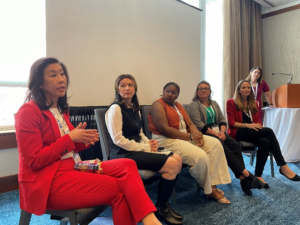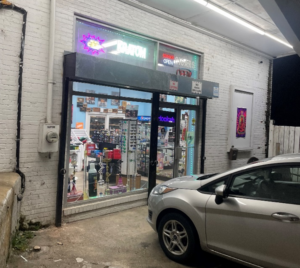April 1 is National Take Down Tobacco Day, led by the Campaign for Tobacco-Free Kids, during which youth advocates and communities come together to stand up to the tobacco industry. This year’s focus is on ending the sale of flavored e-cigarettes that is fueling the youth nicotine addiction crisis.
As of 2019, no one under 21 is allowed to buy tobacco products under U.S. federal law. However, through introducing flavors to tobacco products and deceptive marketing tactics, youth have been drawn to newer tobacco products such as e-cigarettes and vapes, commonly known as their product names, JUUL and Puff Bar. In 2023, 10% of middle and high school students reported current tobacco product use and use of tobacco products in any form by youth is unsafe (1).
Vaping continues to be an issue of high concern to students, parents, and educators, even at the
elementary school level. Like with other industries which recognize and capitalize on their youth influence, from perspectives that may not prioritize youth health, a comprehensive public health approach is critical to prevent youth harms from vaping and other tobacco products. As a school health officer, I feel very fortunate to have local experts to help educate kids and families, not just about the risks of vaping, but also the changing landscape of use, and strategies to support prevention and response. For parents, it is important to support them in their role, and also provide context of how their efforts fit into a broader collaboration to protect youth that involves policy makers, schools, regulatory agencies, and the medical community. And of course, youth themselves. – Patricia Kapunan, MD, MPH, School System Medica Officer at Montgomery County Public Schools
As vaping is an emerging concern for youth in middle schools across the nation, Children’s National has led efforts to speak with school communities at the local and national level on preventing and eliminating tobacco use. Last month, Dr. Susan Walley, Chief of the Division of Hospital Medicine and CHAI Affiliate Faculty at Children’s National and Co-Author of the American Academy of Pediatrics Tobacco Policy Statements (2) presented to a Montgomery County Public School (MD) middle school parent teacher association (PTA) meeting and the National PTA Legislative Conference on youth e-cigarette products and how they are accessed by youth. Her presentations highlighted concerns around tobacco companies selling their products in marginalized communities and the ease of accessing these products in neighborhood stores close to schools. Dr. Walley showed photographs in her presentations of tobacco products available in a nearby gas station or convenience store demonstrating how accessible the products are and how they are marketed to appeal to youth.

March 2024 National PTA Legislative Conference Panel on Youth E-Cigarette Products

Tobacco Products Displayed at a Convenience Store
According to the CDC, 9 out of 10 adults who started smoking cigarettes said they started smoking when they were kids and smoking remains as leading cause of preventable death in the United States (3). As nicotine addiction is a chronic mental health disease and there is strong evidence on the harmful effects of secondhand tobacco smoke, it is recommended that pediatricians screen children and their parents/caregivers for tobacco use. Children’s National is taking action to address this issue through screening for tobacco use in various settings, disseminating preventative messages and supporting adolescents and their parents/caregivers with quitting. In Well Child visits Children’s primary care offices, children are asked about tobacco use and vaping. Children who are admitted to the hospital are screened for tobacco use. After a positive screen, social workers provide the 1-800-QUIT-NOW line and other cessation support resources (4). Nicotine replacement therapy is also available in the hospital’s outpatient pharmacy and available for parents/caregivers that don’t have health insurance. There is more work to be done to help parents/caregivers take the steps to quit smoking and provide educational messages to their children on the harms of tobacco products. E-cigarettes, vaping and teens: what you need to know – Children’s National Rise & Shine Blog (childrensnational.org)
“We know what works to decrease youth use of tobacco products and the U.S. Food and Drug Administration (FDA) has the authority to regulate these products.” – Susan Walley, MD
The greatest opportunity to address this issue is through policy advocacy and systems-level change. A 2023 report called for the FDA to take a stronger stance against retailers that illegally sell tobacco products to children including online retailers and those with histories of noncompliance (5). The FDA did propose new regulations to ban methanol in cigarettes and flavored cigars, which public health experts say could save hundreds of thousands of lives (6).
The District of Columbia has been a leader in our region by enacting a law to ban flavored tobacco products and the sale of electronic smoking devices by prohibiting their sale near any middle or high school campus (7). However, there are opportunities to address enforcement of this policy and provide more systems level education about the harms of tobacco products on youth and communities.
Locally, youth and advocacy organizations can take action by leading public awareness campaigns and enacting comprehensive tobacco-free school policies. For example, a Florida youth organization developed an effective campaign that has mobilized, educated, and equipped youth to speak up to Big Tobacco that they are Not a Replacement (8).
Tobacco use and addiction is an issue that all of us can rally around to address since that affects youth from every community. For more information, go to HealthyChildren.org and takedowntobacco.org.
References
1. Centers for Disease Control and Prevention Morbidity and Mortality Weekly Report. Tobacco Products Use Among U.S. Middle and High School Students – National Youth Tobacco Survey, 2023. Available at https://www.cdc.gov/mmwr/volumes/72/wr/mm7244a1.htm
2. American Academy of Pediatrics. Protecting Children and Adolescents from Tobacco and Nicotine Policy Statement (April 17, 2023). Available at https://publications.aap.org/pediatrics/article/151/5/e2023061804/191066/Protecting-Children-and-Adolescents-From-Tobacco?autologincheck=redirected
3. Centers for Disease Control and Prevention. Youth and Tobacco Use (November 2, 2023). Available at https://www.cdc.gov/tobacco/data_statistics/fact_sheets/youth_data/tobacco_use/index.htm
4. Centers for Disease Control and Prevention. Quitlines and Other Cessation Support Resources (February 27, 2023). Available at https://www.cdc.gov/tobacco/patient-care/quitlines-other/index.html
5. U.S. Department of Health and Human Services Office of Inspector General. FDA County Take Stronger Enforcement Action Against Tobacco Retailers With Histories of Sales to Youth and Other Violations (September 8, 2023). Available at https://oig.hhs.gov/oei/reports/OEI-01-20-00240.asp
6. Christensen, J. FDA takes ‘momentous’ step toward banning menthol cigarettes and flavored cigars (October 24, 2023). Available at https://www.cnn.com/2023/10/16/health/fda-menthol-cigarettes-rules/index.html
7. DC Department of Licensing and Consumer Protection. Flavored Tobacco Prohibition FAQs. Available at https://dlcp.dc.gov/page/flavored-tobacco-prohibition-faqs.
8. Swat Florida (2024). Not a Replacement. Available at https://www.swatflorida.com/
About the author

Julia DeAngelo, MPH
Program Manager for School Strategies within the Child Health Advocacy Institute at Children's National Hospital



